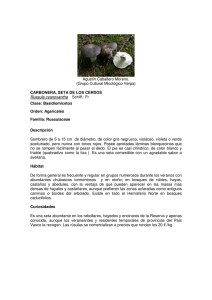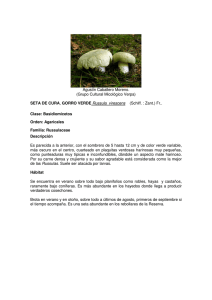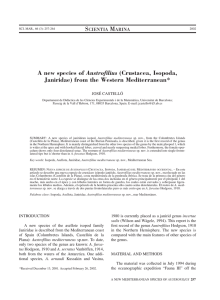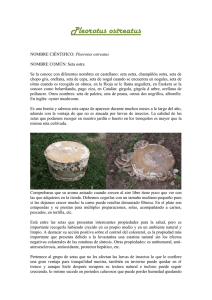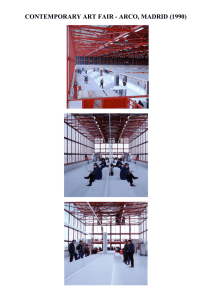Calctrombidium nikolettae n. gen., n. sp.
Anuncio
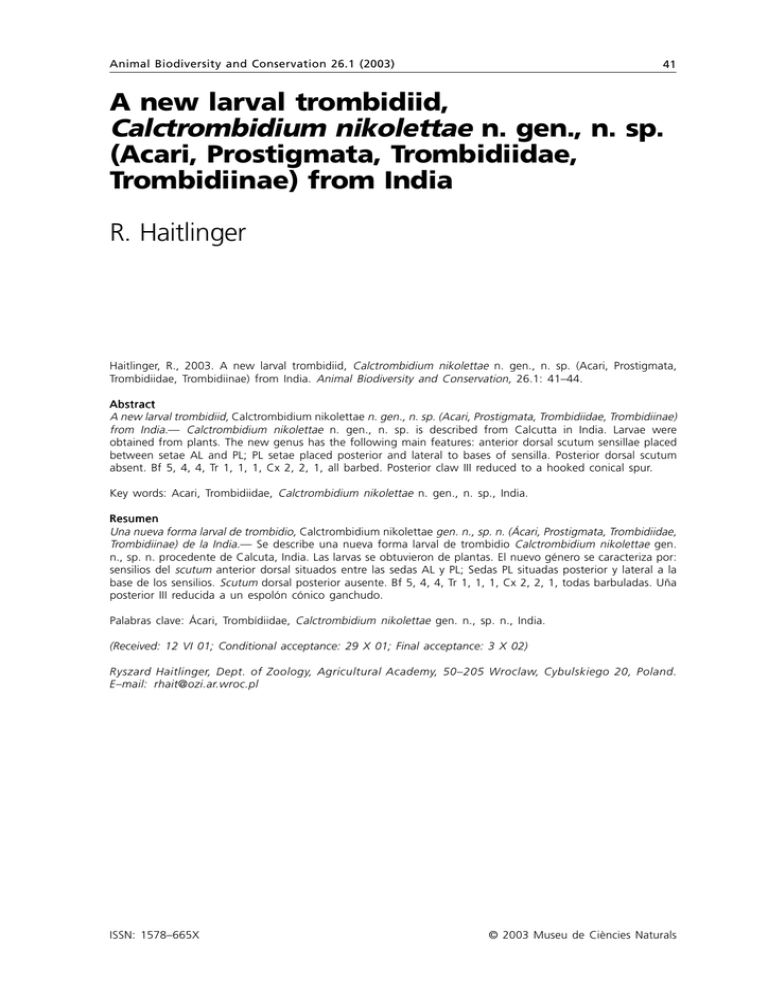
Animal Biodiversity and Conservation 26.1 (2003) 41 A new larval trombidiid, Calctrombidium nikolettae n. gen., n. sp. (Acari, Prostigmata, Trombidiidae, Trombidiinae) from India R. Haitlinger Haitlinger, R., 2003. A new larval trombidiid, Calctrombidium nikolettae n. gen., n. sp. (Acari, Prostigmata, Trombidiidae, Trombidiinae) from India. Animal Biodiversity and Conservation, 26.1: 41–44. Abstract A new larval trombidiid, Calctrombidium nikolettae n. gen., n. sp. (Acari, Prostigmata, Trombidiidae, Trombidiinae) from India.— Calctrombidium nikolettae n. gen., n. sp. is described from Calcutta in India. Larvae were obtained from plants. The new genus has the following main features: anterior dorsal scutum sensillae placed between setae AL and PL; PL setae placed posterior and lateral to bases of sensilla. Posterior dorsal scutum absent. Bf 5, 4, 4, Tr 1, 1, 1, Cx 2, 2, 1, all barbed. Posterior claw III reduced to a hooked conical spur. Key words: Acari, Trombidiidae, Calctrombidium nikolettae n. gen., n. sp., India. Resumen Una nueva forma larval de trombidio, Calctrombidium nikolettae gen. n., sp. n. (Ácari, Prostigmata, Trombidiidae, Trombidiinae) de la India.— Se describe una nueva forma larval de trombidio Calctrombidium nikolettae gen. n., sp. n. procedente de Calcuta, India. Las larvas se obtuvieron de plantas. El nuevo género se caracteriza por: sensilios del scutum anterior dorsal situados entre las sedas AL y PL; Sedas PL situadas posterior y lateral a la base de los sensilios. Scutum dorsal posterior ausente. Bf 5, 4, 4, Tr 1, 1, 1, Cx 2, 2, 1, todas barbuladas. Uña posterior III reducida a un espolón cónico ganchudo. Palabras clave: Ácari, Trombídiidae, Calctrombidium nikolettae gen. n., sp. n., India. (Received: 12 VI 01; Conditional acceptance: 29 X 01; Final acceptance: 3 X 02) Ryszard Haitlinger, Dept. of Zoology, Agricultural Academy, 50–205 Wroclaw, Cybulskiego 20, Poland. E–mail: rhait@ozi.ar.wroc.pl ISSN: 1578–665X © 2003 Museu de Ciències Naturals 42 Introduction The subfamily Trombidiinae Leach consists of 12 genera; some of them were described based only on postlarval instars; five genera were described based on larvae. Now, in this subfamily the following genera based on larvae or adults with known larval instars have been reported: Trombidium Fabricius, Paratrombium Bruyant, Dinothrombium Southcott, Clinotrombium Southcott and Pollicotrombium Southcott. According to SOUTHCOTT (1986), 7 genera based on larvae (or larvae and adults) belonged to this subfamily; later ZHANG & XIN (1992) synonymized the genus Nippotrombium Southcott with the genus Allothrombium Berlese and the genus Acritotrombium Southcott was transferred to the subfamily Allothrombiinae Thor. In this paper, a new genus Calctrombidium for new species C. nikolettae is described from India. To date only two species were known in India, both belonging to the family Trombidiidae: Dinothrombium gigas (Trouessart) based on adults and Allothrombium muscaparasiticae Vishnupriya & Mohanasundaram based on larvae (THOR & WILLMANN, 1947; VISHNAUPRIYA & MOHANASUNDARAM, 1988). Material and methods Two specimens of Calctrombidium nikolettae n. gen., n. sp., were obtained from plants in Calcutta, India. They were mounted in Berlese fluid. The terminology is based on ROBAUX (1974) and SOUTHCOTT (1986). All measurements are given in micrometers (µm). The holotype will be deposited in the Museum of Natural History, Wroclaw University (MNHWU). Results Fam. Trombidiidae Leach, 1815 Subfam. Trombidiinae Leach, 1815 Calctrombidium n. gen. Diagnosis Anterior dorsal scutum sensillae placed between setae AL and PL; PL setae placed posterior and lateral to bases of sensilla. Posterior dorsal scutum absent, but two setae are present in place where scutellum usually is. Basifemur 5, 4, 4, Trochanteralae 1, 1, 1, Coxalae 2, 2, 1, all barbed. Seta 1a (on coxa I) and seta 2a (on coxa II) both placed at anterior margin of these coxae. Posterior claw III reduced to a hooked conical spur. Palptarsus with only short setae, without long and barbed setae. Hypostomalae distally branched. Type species Calctrombidium nikolettae n. sp. Haitlinger Etymology Generic name is derived from the first part of the name: Calcutta, the place of type species collection, and "–tromb–" as a root word of the superfamily. Remarks Calctrombidium n. gen. is similar to genera Trombidium, Dinothrombium and Clinotrombium. It differs from Dinothrombium by PL placed beyond bases of scutal sensilla, proximal coxala II placed near anterior margin of coxa; from Clinotrombium by PL situated at posterior angle of scutum, proximal coxalae I placed at anterior margin of coxae and coxalae II placed near anterior margin of coxae; from Trombidium by barbed coxala 1a and proximal coxala II placed near anterior margin of coxa. Calctrombidium nikolettae n. sp. (figs. 1–8) Examined material Holotype larva, Calcutta, India, 30 II 2001, from herbaceous plants on large recreation ground near centre of Calcutta; paratype, the same data as in holotype; leg. R. Haitlinger; MNHWU. Description Larva Idiosoma elongate. Dorsal surface of idiosoma with 20 very slightly barbed setae, arranged 4, 6, 4, 4, 2. Setae without platelets (fig. 1). Two pairs of eyes, both on platelet; the anterior eye larger than the posterior eye. Dorsal scutum with very weakly barbed AL and PL and distinctly barbed AM. Setae AL about half the length of setae PL. AM = AL. Sensillae distally with setules (fig. 3). Scutellum absent but two setae present in its place. Ventral surface of idiosoma with two intercoxal setae 3a, present between coxae III. Beyond coxae III six setae; two posterior setae weakly barbed (fig. 2). Gnathosoma with palpfemur and palpgenu without setae, palptarsus with seven short and nude setae (with solenidion). Hypostomalae distally branched (figs. 4, 5). Leg lengths (with coxae, without claws) I 300 holotype, 310 paratype; II 274, 284; III 288, 296. Ip = 862, 890. Legs setal formula Leg I. Ta–1ω, 2ζ, 14B; Ti–2ϕ, 5B; Ge–2δ, 4B; Fe– 5B; Tr–1B. Coxa with two barbed setae; seta 1a placed at anterior margin of coxa and seta 1b placed in angle at posterior and lateral margins of coxa (fig. 6). Leg II. Ta–1ω, 1ζ, 11B; Ti–2ϕ, 5B; Ge–1δ, 3B; Fe–4B; Tr–1B. Coxa with two barbed setae; seta 2a near anterior margin of coxa and seta 2b near posterior margin of coxa. Solenidion δ relatively long (36 µm) (fig. 7). 43 Animal Biodiversity and Conservation 26.1 (2003) 1 2 3 4 5 ω ω σ ζ ϕ ϕ ω σ σ 6 ζ ω ϕ ϕ 8 σ ζ 7 Figs. 1–8. Calctrombidium nikolettae n. sp.: 1. Idiosoma, dorsal view, eyes and dorsal seta detailed; 2. Idiosoma, ventral view and ventral seta detailed; 3. Scutum; 4. Gnathosoma and hypostoma detailed; 5. Palptarsus; 6. Leg I, tarsus–coxa; 7. Leg II, tarsus–coxa; 8. Leg III, tarsus– coxa: ω. Solenidion on tarsi I, II; ϕ. Solenidion on tibiae I, II; σ. Solenidion on genu I–III; ζ. Eupathidium. Figs. 1–8. Calctrombidium nikolettae sp. n.: 1. Idiosoma, vista dorsal, ojos y sedas dorsales en detalle; 2. Idiosoma, vista ventral y sedas ventrales en detalle; 3. Scutum; 4. Detalle del gnatosoma y del hipostoma; 5. Palpotarso; 6. Pata I, tarso–coxa; 7. Pata II, tarso–coxa; 8. Pata III, tarso–coxa: ω. Solenidio de los tarsos I, II; ϕ. Solenidio de las tibias I, II; σ. Solenidio del genu I–III; ζ. Eupatidio. Leg III. Ta–11B; Ti–5B; Ge–1δ, 3B; Fe–4B; Tr–1B. Coxa with one barbed seta 3b placed in median part of coxa. Anterior claw strong, recurved; empodium long, slender; posterior claw strong, curved (fig. 8). Measurements IL (length of idiosoma) 1,695 holotype, 1,511 paratype, IW (width of idiosoma) 707, 774, L 80, 78, W 96, 94, AW 80, 80, PW 80, 84, AA 44, ?, SB 54, 58, ASB 62, 60, PSB 18, 18, ISD 50, 42, AP 22, 28, AL 28, 30, PL 58, 54, AM 28, 28, MA 36, 40, S 60, 64, DS 42–52, 44–54, GL 84, 86, SA 16, 16, SP 20, 20, Ocular sclerite 26, –, TaI 82, 80, TiI 44, 48, GeI 34, 30, FeI 50, 60, TrI 36, 36, CxI 54, 56, TaII 66, 70, TiII 42, 44, GeII 26, 26, FeII 50, 48, TrII 36, 40, CxII 54, 56, TaIII 70, 70, TiIII 48, 50, GeIII 26, 28, FeIII 54, 56, TrIII 38, 44, CxIII 52, 48. Remarks This species has common features with Trombidium telletxeae Goldarazena et al. provisionally included with the genus Trombidium. T. telletxeae also has seta 2a situated at anterior margin of coxa, but differs by the presence of scutellum, nude setae 1a and normal claws on tarsus III (GOLDARAZENA et al., 2000). Etymology The name of the species has been derived from the name Nikoletta. 44 References GOLDARAZENA, A., ZHANG, Z.–Q. & JORDANA, R., 2000. A new species and a new record of ectoparasitic mites from thrips in Turkey (Acari: Trombidiidae and Erythraeidae). Systematic Parasitology, 45: 75–80. ROBAUX, P., 1974. Recherches sur le developpement et la biologie des acariens Thrombidiidae. Memoires du Museum National d’Histoire Naturelle (n. s.) Serie A Zoologie, 85: 1–186. SOUTHCOTT, R. V., 1986. Studies on the taxonomy and biology of the subfamily Trombidiinae Haitlinger (Acarina: Trombidiidae) with a critical revision of the genera. Australian Journal of Zoology, Supplementary Series, 123: 1–116. THOR, S. & WILLMANN, C., 1947. Trombidiidae. Das Tierreich, 71b: 187–541. VISHNUPRIYA, R. & MOHANASUNDARAM, M., 1988. Mites associated with insects in Tamil Nadu, India. Entomon, 12: 247–257. ZHANG, Z.–Q. & XIN, J.–L., 1992. Review of larval Allothrombium (Acari: Trombidioidea), with description of a new species ectoparasitic on aphids in China. Journal of Natural History, 26: 383–393.
